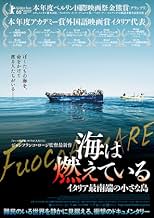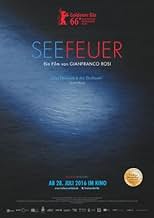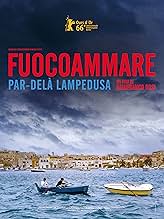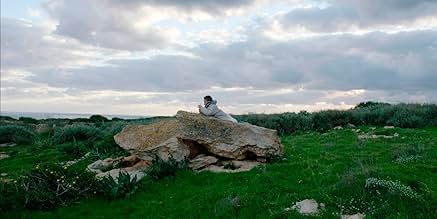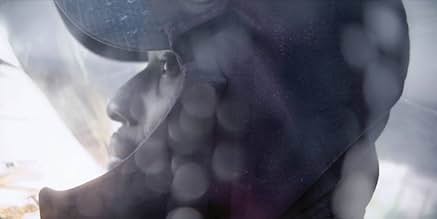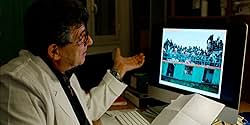Adicionar um enredo no seu idiomaCapturing life on the Italian island of Lampedusa, a frontline in the European migrant crisis.Capturing life on the Italian island of Lampedusa, a frontline in the European migrant crisis.Capturing life on the Italian island of Lampedusa, a frontline in the European migrant crisis.
- Direção
- Roteiristas
- Artistas
- Indicado a 1 Oscar
- 16 vitórias e 28 indicações no total
- Direção
- Roteiristas
- Elenco e equipe completos
- Produção, bilheteria e muito mais no IMDbPro
Avaliações em destaque
I felt right at the start that this is going to be great. The colors, the photography, the sound, everything lead to show me the harmony and the inner glow of Lampedusa and it's inhabitants, and the pragmatic, dramatic contrast of the migrants.
So much Charm. Wow! This movie is relaxes, shows drama in other ways...
Usually I don't even like slow films: with few cuts, few actions: But that one...blow me away.
It's like living there, essentially with them, feeling their emotions, the salty sea air on our skin... And I think this is mainly because of the "local actors". Rossi and the Cast made a ,,capolavoro" capturing and playing their life that way.
Congratulations!
We see the Italian navy rescuing migrants from their sinking overcrowded boats and dinghies; many of them are in a desperate condition after days at sea. We get glimpses of the 'internment camp'where they wait to be processed and sent on to their uncertain future in a Europe which is increasingly unwelcoming.
Alternating with the refugee crisis, the film's main focus is Samuele, a 12-year-old Lampedusan who lives with his fisherman father and grandmother. The family play themselves in the style of a Pasolini movie (minus the sex and the blasphemy). We watch Samuele slurping spaghetti, struggling with homework, playing with a slingshot. They seem to have a very limited awareness of the migrant situation, although that is perhaps only the director's way of pointing up the contrast between the ordinariness of their lives and the appalling tragedy taking place in the waters around their island.
This heart-wrenching film offers no solution to the crisis. How could it? There clearly isn't one.
And yet, that's exactly what director Gianfranco Rosi has tried to do in this documentary. He must have spent many months with the Italian coast guard, which tracks down the vessels with refugees. And he must have shot an immense quantity of footage, because it's clear he has selected only the best material.
The film doesn't explain or elaborate. It just shows, as a good movie is supposed to do. There is some very shocking footage, but also plenty of small, almost ordinary scenes like a beautiful shot of a helicopter taking off, or a doctor doing a check-up of a newly arrived refugee pregnant with twins.
But there are not only scenes of refugees. There is also daily life on the island, which we see through the eyes of a small boy. The contrast between the calm, uneventful lives of the boy and his family, and the utter despair and misery of the refugees, is what makes this film special. It also offers the viewer some relief from the grim scenes at sea. Some of the scenes featuring the boy are really funny, such as his visit to the doctor because of an imagined illness.
The editing of the film is great. There is a slow build-up, with scenes whose meaning is not immediately clear. But later on, things fall into place. The most shocking footage is shown near the end. Also, there is a very good balance between the rescue scenes at sea and almost poetic scenes of daily life on the island.
Você sabia?
- CuriosidadesDirector Gianfranco Rosi did his own cinematography again, but used for the first time an ARRI Amira camera, which he said allowed him to shoot in dark environments: "Sometimes it looked like we had an incredible amount of light. Technology helped me a lot on this film. Being able to work with this tiny camera by myself was an incredible tool." [2016]
- Citações
Nigerian Refugee: This is my testimony... We could no longer stay in Nigeria. Many were dying. Most were bombed... We flee from Nigeria. We ran to the desert. We went Sahara Desert and many died... Raping and killing many people, and we could not stay. We flee to Libya. And Libya was a city of ISIS. And Libya was a place not to stay... On the journey on the sea, 200 passengers died. They got lost to the sea. A boat was carrying 90 passengers. Only 30 were rescued, and the rest died. Today we are alive...
Principais escolhas
- How long is Fire at Sea?Fornecido pela Alexa
Detalhes
Bilheteria
- Faturamento bruto nos EUA e Canadá
- US$ 120.933
- Faturamento bruto mundial
- US$ 1.178.377
- Tempo de duração
- 1 h 54 min(114 min)
- Cor
- Mixagem de som
- Proporção
- 1.85 : 1

![Assistir a Trailer [OV]](https://m.media-amazon.com/images/M/MV5BNmQ3ZjU0NzktZWFmNi00YzMxLTg1N2UtMGM3ZTgwMDU3OWJlXkEyXkFqcGdeQXRodW1ibmFpbC1pbml0aWFsaXplcg@@._V1_QL75_UX500_CR0)


